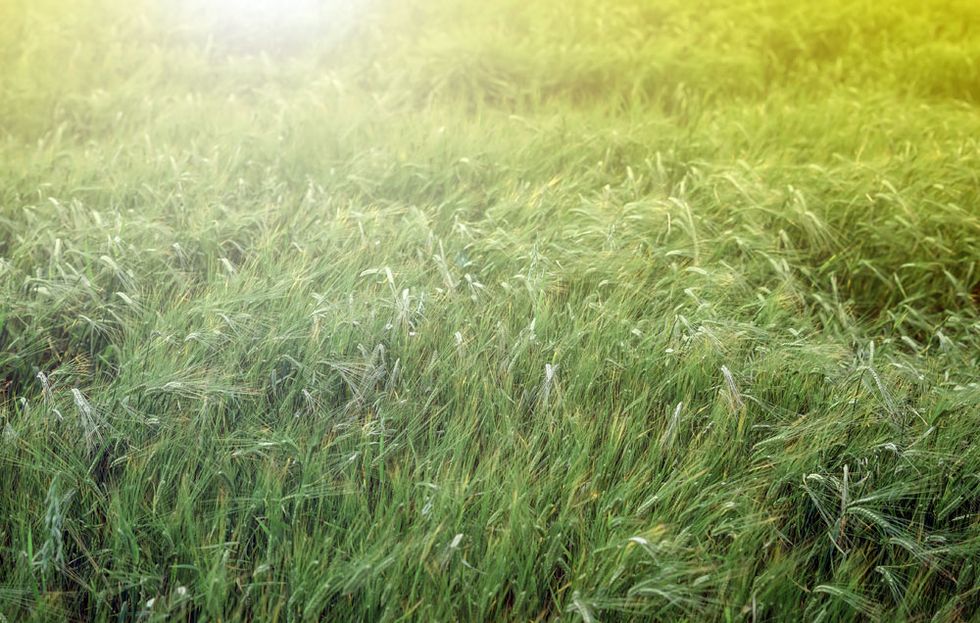Cover crops just might be the hardest-working plants you’ll ever grow. Cover crops (also called green manure) suppress weeds, build productive soil, and help control pests and diseases. Plus, cover crops are easy to plant and require only basic care to thrive. And they grow well in nearly every part of the country.
(On just a quarter-acre of land, you can produce fresh, organic food for a family of four—year-round. Rodale's The Backyard Homestead shows you how; get your copy today.)
Get Started!
Maybe you already know about the benefits of cover crops but think they’re just for farmers and other large-scale growers. Think again. Cover crops are well suited to all gardens, whether they’re big or small. Here’s a step-by-step guide to reaping the rewards of cover crops in your garden.
Planting Cover Crops
If you’ve ever reseeded a bare patch in your lawn, rest assured you can plant a cover crop. Work up the soil gently with a garden rake, broadcast seed over the soil, and then rake it in. Raking establishes good soil-to-seed contact and protects the seed from birds. "Birds sometimes eat the seeds if they are too close to the surface," says Nancy Creamer, Ph.D., director of the Center for Environmental Farming Systems at North Carolina State University. If you decide to plant cover crops in the fall, be sure to allow them plenty of time to become established. "This means planting them 4 weeks before killing frosts. The one exception is cereal rye, which can be planted right up to a frost," says Marianne Sarrantonio, Ph.D., associate professor of sustainable agriculture at the University of Maine.
Related: How To Control Weeds Naturally Using Cover Crops
Caring For Cover Crops
Cover crops are low-maintenance compared to most crops, but they still need some care. Mowing keeps large cover crops manageable, and sorghum-sudangrass actually increases its root growth if mowed once or twice. White Dutch clover planted in garden pathways needs to be mowed regularly to keep it from competing with vegetables and flowers. Be sure to water cover crops during times of drought.
Timing Your Cover Crop Kill
You must kill your cover crops before they set seed and the topgrowth gets out of control. That’s right, kill them. “The best time to kill them is at flowering or when the seedheads emerge on grains. The annuals can all be killed at this point by cutting at the base of the plant,” advises Sarrantonio.
You can mow cover crops with a lawn mower or a weed trimmer, depending on how tall the plants are. Wait a day or two until the leaves and stems dry down, and then dig them in. Longer pieces of stems and vines may interfere with tilling, but it won’t take long before the vegetative growth partially decomposes.
After turning under a cover crop of grasses, wait 2 to 3 weeks before planting vegetables or flowers. The decomposition of the green material can tie up soil nitrogen. And cover crops such as rye are allelopathic, which means they inhibit seed germination.
Finding Space In Your Garden
When I discuss cover crops in gardening classes, a common concern is the amount of valuable garden space they occupy. However, you can fit cover crops right into your garden plan.
Succession cropping is one of the easiest ways to do this. After spring crops of lettuce, radishes, and other early vegetables have been harvested, plant a fast-growing cover crop, such as buckwheat. In most climates, you can allow this cover crop to flower and still have time to plant a crop of frost-tolerant vegetables. Cover crops can also be planted in fall after some main-season crops, such as cabbage, are finished.
Related: Protect Your Garden With Cover Crops
Interplanting cover crops with vegetables is possible, though a bit trickier. “Ample water and nutrients available to both cover crops and vegetable crops, and controlling growth of the cover crop, are key to making this approach work," cautions Creamer. It’s also important to delay your planting of the cover crop. “A good rule of thumb is to sow the cover crop seed into the vegetable bed one-third of the way through the vegetable crop’s growing cycle,” says Steve Diver of ATTRA—The National Sustainable Agriculture Service. For example, if you’ve planted a 75-day corn variety, interplant a cover crop about 25 days after seeding the corn. Organic farmers have had good luck with delayed interplantings of yellow blossom sweet clover with lettuce and onions. Sarrantonio suggests transplanting young tomato and pepper plants into a mowed mulch of hairy vetch and rye. The mulch reduces weeds, maintains moisture, and provides nitrogen.
The Easiest Cover Crops To Grow
Which cover crop is right for you? "You have to keep in mind the time of year and the species you are growing," says Diver. Some, such as cereal rye, are very cold-tolerant and work well for late-season plantings. Others, such as buckwheat, are very frost-tender. The cover crops listed here are widely adapted and can be grown in most areas of the United States, either as a summer or winter cover crop, depending on where you live.
Related: 5 Cover Crops That Will Keep A Small Plot Healthy
Rye
This crop comes in two different types: annual rye and cereal rye. Both have their advantages. Sow cereal rye during the late summer or early fall, and it will grow until late in fall and resume growing in spring. With annual rye, which winterkills in USDA Plant Hardiness Zones 5 and colder, you’ll be able to plant your garden earlier, since you won’t have to turn the cover crop into the soil and then wait 3 weeks as you would with a perennial cover crop.
Field peas/oats
This dynamic duo combines the benefits of a legume (peas) that fixes nitrogen and a grain (oats) that contributes plenty of organic matter. And the plants have complementary growth habit—the peas climb right up the oats. Both crops are cold-tolerant, which makes this a good mixture to plant in late summer or early fall. In colder climates, they will also winterkill, allowing an early spring start.
Sorghum-sudangrass
As its name suggests, this grass is a cross between sorghum and sudangrass. This hybrid generates large amounts of organic matter and needs little encouragement to grow 5 to 12 feet tall. You can keep this frost-tender plant in check by mowing it down to 6 inches when it reaches a height of 3 feet or by planting it just 7 weeks before frost.
Buckwheat
It’s not wheat, and it’s not a Little Rascals character! Buckwheat is a broadleaf plant and an excellent smother crop—it’s effective even against weeds like quackgrass. “Buckwheat is very fast-growing and can provide a quick canopy to shade weeds. Just be careful to not let it go to seed, or you’ll have buckwheat in your next crop," says Creamer. It matures in just 6 to 8 weeks and can be squeezed in between spring and fall vegetable plantings. Buckwheat’s white flowers serve two purposes—they work well as a filler for flower arrangements, and they attract beneficial insects.
Clover
Clover comes in a plethora of different shapes and sizes. White Dutch clover works well as a living mulch, since it tolerates both shade and traffic. Yellow blossom sweet clover is an excellent nutrient scavenger and helps build good soil structure. Crimson clover attracts beneficials and looks great, too. Whatever the color, clover fixes nitrogen and helps to build rich soils. For best results, make sure you inoculate your clover seed with Rhizobium bacteria.















